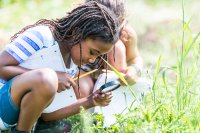Outdoor Adventures With Students
Exploring nature with elementary students can be memorable and fun with a little advance planning and preparation.
Your content has been saved!
Go to My Saved Content.For teachers who love nature, hiking a trail, canoeing a local lake, or birdwatching in the woods are peaceful and rejuvenating ways to escape civilization. As a teacher, I want to share my passion for the outdoors with my students.
Many students (and the parents or guardians who sign the permission slips) have reservations about experiences outdoors. While students spend time outside at ball fields, playgrounds, and backyards, many have little experience in more natural settings, and this inexperience can create fear. Carefully planned and executed adventures outdoors can give students a positive perspective on learning outside.
Preparing for Adventure
As educators, we can either forgo nature excursions, plunge forward and hope for the best, or choose careful preparation to make sure our students feel comfortable in these experiences.
In Ohio, students are justifiably concerned about tick-borne disease or a rash; our woods are infested with poison ivy and ticks. There are also smaller worries like muddy trails, mosquitoes, and fears of getting lost.
I start talking about these concerns about a week before we hit the woods, which gives my fifth graders time to voice their fears. Talking about potential hazards in advance allows a class to plan carefully for avoiding them. Proper equipment can address some concerns. I require long pants and old shoes or boots, and I suggest hats and insect repellent for those who so choose. We have a few pairs of old boots for kids who need to borrow them.
I email parents or guardians about our plans and enlist their help for tick checks after we return. My email reviews our safety rules and goals for the trip, so parents feel comfortable about the experience beforehand.
Including Parents or Other Adults
A nature trip works better with extra adult supervision. It is difficult to hear bird calls, to make careful observations, or to complete work tasks with a large group of students together. Recruiting parent or other adult volunteers allows groups of students to wander off and experience the outdoors in a more intimate way.
At the outset, create smaller independent groups, including adult mentors, and provide each group with rules and expectations. It is important to explain the process to the whole class. Our nature preserve is small, but I do talk about what to do if students get separated from the class, including how to get back to the group if necessary.
Parents are not the only possible adult mentors; I also like to enlist our local forester for help in identifying trees and getting students excited about what our nature preserve offers.
Offering Choices About How Students Participate
Students respond to outdoor activities when they are given choices about the different roles because they are allowed to participate at their own comfort levels.
One of the activities at our school is the BioBlitz, in which a group attempts to identify as many species as we can in a short period of time. I take classes into our wetland areas and woods to take photos of living things, and we use a free app called iNaturalist to identify and catalog our findings.
Adventurous students roam off trail and dig under logs, walk into the shallow ponds, and search for animal tracks in our small stream. Others choose to stay on the trails and take photos of flowers and creatures without getting too close. Just because some students are slower to jump off-trail doesn’t mean they aren’t participating. When we give less-adventurous students assignments that accommodate their comfort levels, they slowly overcome their fears and can jump into the work at their own pace. Many reluctant students gradually grow bolder as they see their classmates make discoveries by leaving the safety of the trail. The opportunity to work together and have fun also encourages deeper engagement.
Finding Resources
There are many organizations looking to help educators take students outside. Currently, Target offers field trip grants of up to $700 for teachers looking to get away from the classroom. NEA members can apply for Student Achievement Grants of between $2,000 and $5,000, which could be used for a trip to a nature preserve, state park, or other outdoor area.
Many states have programs through their state or city parks with funding set aside for environmental education. In my state, the Ohio Environmental Education Fund pays for field trips to metropolitan parks, helps schools plant gardens, and funds stream quality monitoring and other efforts toward wildlife research. Many of these grants are given to urban schools where students may have little access to nature.
Remembering the Reason
The first forays into nature with students don’t need to be major expeditions, and educators don’t need to be naturalists or wildlife experts to lead a successful trip. Activities outdoors can be instructive and fun for students in all disciplines. A scavenger hunt, photo walk, leaf collection, or nature journaling or sketching activity can get kids excited about the outdoors without fancy equipment or extensive knowledge. Students marvel at the smallest of natural encounters—spotting a frog, running alongside a butterfly, or discovering a beetle beneath a log.
Taking students outside is worth the effort. Richard Louv summed it up in his book Last Child in the Woods: Saving Our Children From Nature-Deficit Disorder, writing, “Time in nature is not leisure time; it’s an essential investment in our children’s health (and also, by the way, in our own).” Exploring the world around us creates learning opportunities that can’t be recreated in the classroom. These opportunities are not always as straightforward as lessons from a textbook, but they can be more memorable and fun.
